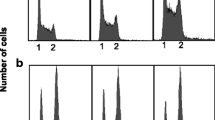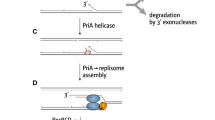Summary
A T7 amber mutant, UP-2, in the gene for T7 DNA-binding protein was isolated from mutants that could not grow on sup + ssb-1 bacteria but could grow on glnU ssb-1 and sup + ssb +bacteria. The mutant phage synthesized a smaller amber polypeptide (28,000 daltons) than T7 wild-type DNA-dinding protein (32,000 daltons). DNA synthesis of the UP-2 mutant in sup + ssb-1 cells was severely inhibited and the first round of replication was found to be repressed. The abilities for genetic recombination and DNA repair were also low even in permissive hosts compared with those of wild-type phage. Moreover, recombination intermediate T7 DNA molecules were not formed in UP-2 infected nonpermissive cells. The gene that codes for DNA-binding protein is referred to as gene 2.5 since the mutation was mapped between gene 2 and gene 3.
Similar content being viewed by others
References
Araki H, Ogawa H (1981) The participation of T7 DNA-binding protein in T7 genetic recombination. Virology 111:509–515
Baas PD, Keegstra W, Teertstra WR, Jansg HS (1978) R-loops in bacteriophage ϕX174 RF DNA. J Mol Biol 125:187–205
Campbell A (1965) The steric effect in lysogenization by bacteriophage lambda. I. Lysogenization of a partially diploid strain of Escherichia coli K12. Virology 27:329–339
Clark AJ, Chamberlin M, Boyce RP, Howard-Flanders P (1966) Abnormal metabolic response to ultraviolet light of a recombination deficient mutant of Escherichia coli K12. J Mol Biol 19:442–454
Clowes RC, Hayes W (1968) Experiments in microbial genetics. Wiley, New York
Glassberg J, Meyer RR, Kornberg A (1979) Mutant single-strand binding protein of Escherichia coli: genetic and physiological characterization. J Bacteriol 140:14–19
Hausmann R (1976) Bacteriophage T7 genetics. Curr Top Microbiol Immunol 75:77–110
Ikeda H, Tomizawa J (1965) Transducing fragments in generalized transduction by phage P1. I. Molecular origin of the fragments. J Mol Biol 14:85–109
Mark FD, Chase JM, Richardson CC (1977) Genetic mapping of trxA, a gene affecting thioredoxin in Escherichia coli K12. Mol Gen Genet 155:145–152
Masukata H, Ogawa T, Ogawa H (1979) The R-loop structure of λ DNA in dnaG mutant of E. coli. Abstracts of the annual meeting of the American Society for Microbiology-1979, 137
Meyer RR, Glassberg J, Kornberg A (1979) An Escherichia coli mutant defective in single-strand binding protein is defective in DNA replication. Proc Natl Acad Sci USA 76:1702–1705
North R, Molineux IJ (1980) A novel mutant of bacteriophage T7 that is defective in early phage DNA synthesis. Mol Gen Genet 179:683–691
Ogawa T (1975) Analysis of the dnaB function of E. coli K12 and the dnaB-like function of P1 prophage. J Mol Biol 94:327–340
Ogawa T, Tomizawa J (1967) Abortive lysogenization of bacteriophase lambda b2 and residual immunity of non-lysogenic segregants. J Mol Biol 23:225–245
Reuben CR, Gefter ML (1973) A DNA-binding protein induced by bacteriophage T7. Proc Natl Acad Sci USA 70:1846–1850
Reuben CR, Gefter ML (1974) A deoxyribonucleic acid-binding protein induced by bacteriophage T7. Purification and properties of the protein. J Biol Chem 249:3843–3850
Richardson CC, Romano LJ, Kolodner R, LeClerc JE, Tamanoi F, Engler MJ, Dean FB, Richardson DS (1978) Replication of bacteriophage T7 DNA by purified proteins. Cold Spring Harbor Symp Quant Biol 43:427–440
Sancar A, Rupp WD (1979) Cloning of uvrA, lexC and ssb genes of Escherichia coli. Biochem Biophys Res Commun 90:123–129
Scherzinger E, Klotz G (1975) Studies of bacteriophage T7 DNA synthesis in vitro. II. Reconstitution of the T7 replication system using purified proteins. Mol Gen Genet 141:233–249
Scherzinger E, Litfin F, Jost E (1973) Stimulation of T7 DNA polymerase by a new phage-coded protein. Mol Gen Genet 123:247–262
Sevastopoulous CG, Wehr CT, Glaser DA (1977) Large-scale automated isolation of Escherichia coli mutants with thermosensitive DNA replication. Proc Natl Acad Sci USA 74:3485–3489
Shapiro AL, Vinuela E, Maizel JV (1967) Molecular weight estimation of polypeptide chains by electrophoresis in SDS-polyacrylamide gels. Biochem Biophys Res Commun 28:815–820
Studier FW (1969) The genetics and physiology of bacteriophage T7. Virology 39:562–574
Studier FW (1973) Analysis of bacteriophage T7 early RNAs and proteins on slab gels. J Mol Biol 79:237–248
Tomizawa J, Anraku N, Iwama Y (1966) Molecular mechanism of genetic recombination of bacteriophage. VI. A mutant defective in the joining of DNA molecules. J Mol Biol 21:247–253
Tsujimoto Y, Ogawa H (1977) Intermediates in genetic recombination of bacteriophage T7 DNA. J Mol Biol 109:423–436
Tsujimoto Y, Ogawa H (1978) Intermediates in genetic recombination of bacteriophage T7 DNA. Biological activity and the roles of gene 3 and gene 5. J Mol Biol 125:255–273
Author information
Authors and Affiliations
Additional information
Communicated by T. Yura
Rights and permissions
About this article
Cite this article
Araki, H., Ogawa, H. A T7 amber mutant defective in DNA-Binding protein. Molec. Gen. Genet. 183, 66–73 (1981). https://doi.org/10.1007/BF00270140
Received:
Issue Date:
DOI: https://doi.org/10.1007/BF00270140




